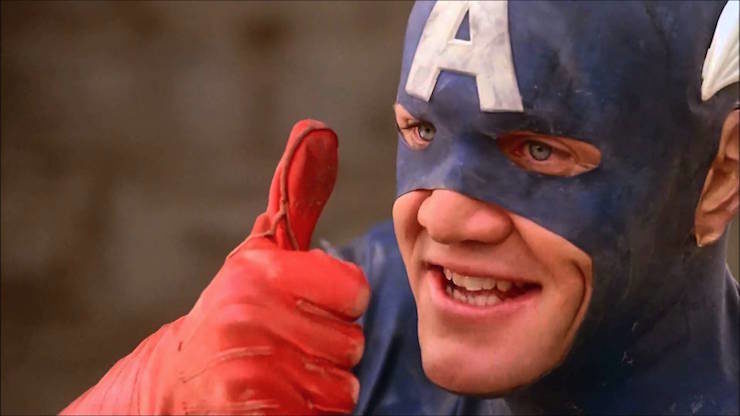Throughout the 1980s and 1990s, Marvel Comics kept trying to do their characters in Hollywood. In 1981, Stan Lee moved from New York to California to head up Marvel’s screen department. There were tons of false starts and poor attempts, as Marvel sold their film rights to any number of companies that made a pig’s ear out of it, or never got the film out. (I lost track of the number of Spider-Man films in development in the last two decades of the twentieth century, one of which was supposed to be directed by James Cameron.) We’ve already covered two of the disasters that got made: The Punisher and Howard the Duck.
Two more that were actually filmed, after long and tumultuous production histories, were never released theatrically in the U.S. Captain America, starring Matt Salinger, was released to theatres in the UK in 1990, but didn’t see the light of day in the States until 1992 on home video. Fantastic Four, executive produced by schlockmeister Roger Corman, never even got an official release, and Marvel denied its existence for a while until bootlegs started showing up on VHS.
The rights to Captain America in live-action were purchased by Cannon films in 1984, and the movie went through several script notions before the one they settled on for the 1990 film. When producer Menahem Golan was let go from Cannon, part of his severance package was to continue to control the film rights to Captain America. (Hollywood is weird.) He brought in Albert Pyun to direct, and the film was finally done.
Salinger played the title role, and if the name sounds familiar, it’s because he’s the son of the author of The Catcher in the Rye, J.D. Salinger. The younger Salinger is best known for his behind-the-scenes work as a producer these days—goodness knows, this movie didn’t do his acting resumé any favors.
Pyun at least provided Salinger with a strong supporting cast: Ronny Cox, Ned Beatty, Bill Mumy, Francesca Neri, and Ralphie’s parents themselves, Darren McGavin & Melinda Dillon (you ever want to stump someone in a trivia contest, ask what other movie Dillon and McGavin starred in together that wasn’t A Christmas Story).
Fantastic Four also had the son of someone more famous, in Joseph Culp, son of Robert Culp of I, Spy and The Greatest American Hero fame. Culp played Doctor Doom, and he’s likely the only actor in this film you’ve heard of. (Well, okay, Mercedes McNab of Addams Family Values and Buffy the Vampire Slayer fame plays young Sue Storm.)
Both movies were plagued by delays and behind-the-scene shenanigans. Neue Constantin made the FF film quickly and on a low budget because if they didn’t, they’d lose the rights. Making the film extended their option by another ten years, and they were eventually able to do a more big-budget FF film, which came out in 2005 (and which we’ll cover, along with its 2007 sequel and 2015 reboot, in due course). Captain America was supposed to come out for the character’s fiftieth anniversary in 1990, but that didn’t really happen. (We won’t even get into the irony of a Captain America film only being released theatrically in England.)
“That was a gun—this is a detonator”
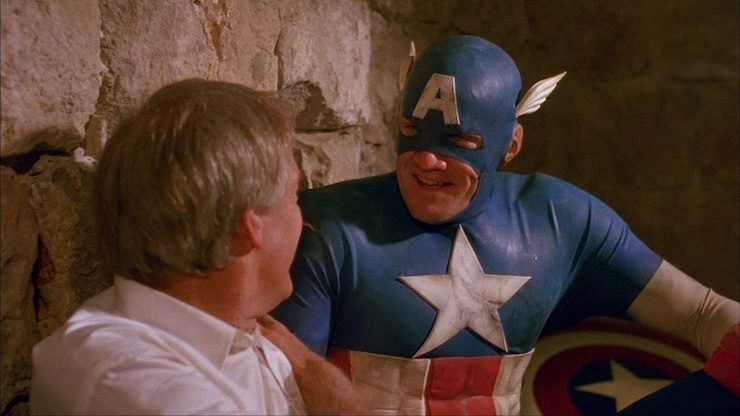
Captain America
Written by Stephen Tolkin and Lawrence Block
Directed by Albert Pyun
Produced by Menahem Golan
Original release date: December 14, 1990
In 1936 Italy, a young prodigy’s piano playing—which is being recorded by his parents—is interrupted by Axis soldiers, who take him away and kill his family while he watches. He is the subject of an experimental procedure, created by a scientist named Dr. Maria Vaselli. It made a rat stronger and smarter, but also turned its epidermis red. The child is to be the next subject.
Horrified by her work being used to experiment on a child, Vaselli jumps out a window and escapes Italy to the United States.
Seven years later, she has spearheaded Project: Birthright, having perfected the process so it no longer turns the subject red. She also created a bulletproof shield that is a perfect boomerang and a fire-proof suit. The secret to how she created all these things is never written down, as she fears for security.
Of all the volunteers for the process, the one the Army picks is Steve Rogers, who suffers from polio, and whose father was a war hero in World War I. His girlfriend Bernie is less than thrilled at him going off on some secret mission.
The experiment is a success, but one of the observers, a man named Ehrlich who was escorted in by Lieutenant Fleming, turns out to be a Nazi spy and he shoots Vaselli dead. Rogers, now super-strong, kills Ehrlich.
Rogers recovers quickly from his gunshot wound, suffered at Ehrlich’s hands, and he is sent to try to stop a rocket created by the Red Skull (the child prodigy, all grow’d up and now with bright red skin) from destroying the White House. Captain America arrives at the Skull’s secret base only two days after he got his powers and gets his ass handed to him by the Skull. Cap is tied to the rocket so he will die when it explodes in D.C. Cap grabs the Skull’s hand, and refuses to let go, with the notion of taking the Skull with him. Rather than use his superior strength to pull away, he pulls out a knife and uses it to cut through his own wrist, er, somehow, in order to be free. (Why he doesn’t, say, cut off Cap’s hand instead is left as an exercise for the viewer.)
A young boy from Springfield, Illinois named Tom Kimball is visiting D.C. with his family. He sneaks out of the house to take a picture of the White House. He sees the missile flying toward the White House and takes a picture of it, too. Cap—who has just endured a transatlantic flight on a missile—waits until the last second to try kicking the tail of the missile so it will change course. This gets the missile to turn up and away from Washington and wind up in Alaska, er, somehow.
Kimball shows the picture to his best friend, Sam Kolawetz. Time passes in a montage of newspaper front pages, that show the passage of time and the life of Kimball, who joins the service, is a war hero in his own right, becomes a Congressperson, and eventually is elected president of the United States in 1992. Kolawetz, for his part, is now a reporter for the Washington Dispatch, and he is convinced that the Red Skull is still alive and the head of an international consortium that is responsible for many horrible things.
President Kimball is planning to attend a conference in Rome that will get rid of toxic waste and other environmental stuff. Fleming—who somehow managed to get himself promoted to general and made Chair of the Joint Chiefs of Staff even after he escorted a Nazi agent into a top-secret military facility in the middle of a war—tries to talk him out of the bill and fails. We soon find out that Kolawetz is 100% right about the Skull, and Fleming is part of his consortium. However, the Skull refuses to have Kimball assassinated—he tried that with the Kennedy brothers and Dr. Martin Luther King Jr., and they just became martyrs. Better instead to kidnap him and insert a mind-control device into his brain. Right.
Two dudes are hiking through Alaska and find a red glove sticking out through the ice. It’s attached to a body, and they bring it back to their base. Cap manages to break out of the ice cube he’s been in for five decades and immediately starts to walk. He walks south through Canada, not having any idea where he is or where he’s going.
One of the dudes took a picture, and this wound up in the newspaper. Red Skull sees this, realizes that his arch-nemesis who made him cut off his hand is back somehow, and he sends his very young daughter Valentina to go take care of it.
Kimball sees the same newspaper report and he tells Kolawetz about it. The reporter immediately heads north.
Even though it’s been a few days—the newspaper report wouldn’t have hit until the day after Cap walked out, and it probably would have taken another day for it to reach the European paper the Skull reads it in, and then another day to fly from Italy to western Canada—Valentina and her goons find Cap as he walks through the forests of Canada. Because finding one person in the middle of friggin Canada is just that easy. Kolawetz is also very nearby, er, somehow. Kolawetz sees the Italian goons shooting at Cap and gives him a lift. Cap is very confused by what’s going on, especially getting a lift from a guy driving a German pickup truck and trying to interview him with a tape recorder made in Japan. He pretends to be sick, which lures Kolawetz out of the truck, and then Cap drives off in the pickup.
After running out of gas, he stows away onto a tractor-trailer and makes his way to his old home in southern California only to find an elderly Bernie living with her husband and their daughter Sharon. Bernie is thrilled to see that Rogers survived, though she’s confused at how he looks the same.
Sharon lets Rogers crash at her place. He watches the news and looks through Kolawetz’s files and realizes that fifty years really have passed.
Kolawetz is back in his office, er, somehow, and he gets his hands on the Project: Birthright plans, er, somehow, and then flies to California to talk to Bernie—the file includes a letter Bernie wrote to Rogers back in the day. However, the Skull has bugged Kolawetz’s phone, so he sends Valentina to California. They shoot Bernie’s husband, Bernie, and Kolawetz. Only the husband survives. Sharon and Rogers arrive just as Kolawetz expires from his wounds, and Kolawetz, rather than say, “Hey, why’d you abandon me in Canada, you putz?” asks Rogers to give Kimball their decoder ring from when they were kids.
Rogers decides that the best way to find the Skull is to find Vaselli’s diary, which is probably in the secret lab, which was under a diner. Rogers and Sharon break in to the back room that leads to the lab, followed quickly by Valentina and her goons. (Why Sharon decides to go on a dangerous mission with the guy partly responsible for her mother’s death is left as an exercise for the viewer.) A firefight ensues, but our heroes are triumphant. Sharon can read Italian because she spent a plot-convenient semester in Venice, and while Vaselli never knew the name of the kid who was transformed into the Skull, she does know the village and the name of the house they lived in.
They fly to Rome, er, somehow—Rogers has no ID, no passport, no nothin’, except maybe a set of dogtags that identify him as someone born in the 1920s—and Rogers tries the same trick to leave Sharon behind that he did with Kolawetz. But when he arrives at the Skull’s boyhood home, the folks only speak Italian. Luckily, Sharon got a cab and followed him and she translates. They find the recording of the child’s piano playing, which also recorded the boy being kidnapped and his family gunned down.
The Skull kidnaps Kimball. It will take 24 hours after an injection before his brain will be ready for the implant that will control him.
Valentina and her goons try to kill Sharon and Rogers, but they escape, and Sharon gets her hands on Valentina’s purse, which she dropped in the café during the fight. Sharon then lets herself get kidnapped, freeing Rogers to don his suit and infiltrate the Skull’s HQ.
Kimball manages to escape on his own, since the title character doesn’t seem to actually be any good at superheroing, and he comments about how Sharon has been kidnapped even though he can’t possibly know who Sharon is. Cap fights off various goons, finally confronting the main bad guy. The Skull, however, has a huge bomb under his HQ that he’s going to detonate.
Sharon faces off against Valentina, while Kimball discovers that Fleming is working for the Skull. Cap plays the recording of the night the Skull watched his family being murdered to distract him long enough to toss his shield at him so he falls over a cliff into the water. On its return, the shield hits Valentina, probably killing her. Kimball calls in the Marines, and the day is won. Cap gives Kimball the decoder ring that Kolawetz entrusted to him.
“It’s clobberin’ time!”
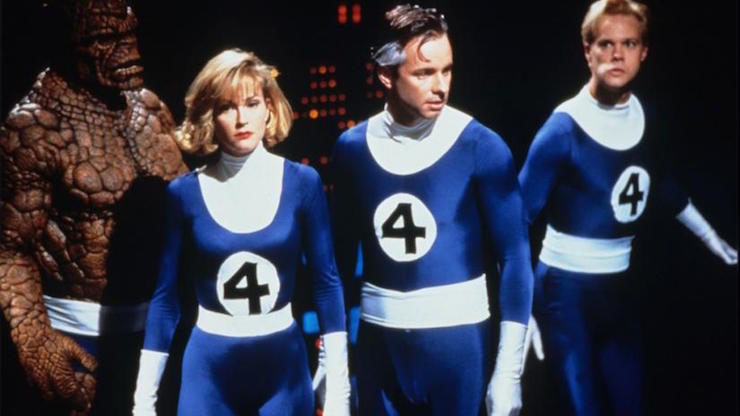
Fantastic Four
Written by Craig J. Nevius and Kevin Rock
Directed by Oley Sassone
Produced by Steven Rabiner
Never officially released
A comet called Colossus passes by Earth once every ten years. Two grad students, Reed Richards and Victor von Doom, are working on a project to harness its energy. Richards’s best friend is Ben Grimm, and the pair of them rent rooms in a boarding house run by the Storm family, including daughter Susan and son Johnny—the former is a pre-teen with a crush on Richards.
Richards and von Doom’s experiment fails, and von Doom is believed killed—but, in fact, he has two flunkies undercover at the university, and they spirit away his body from the hospital and revive him, though he is badly scarred.
Ten years later, Grimm returns from a stint in the Air Force to discover that Richards has built a space shuttle that will fly close to Colossus on this decade’s pass and harness its energy, and he wants Grimm to fly it. Richards has been working on this for ten years, and the final component is delivered: a gigunda diamond to channel the heat.
While the diamond is delivered, Grimm and a blind sculptor named Alicia Masters bump into each other. It’s love at first touch, but the moment passes.
Both von Doom and a creepy old dude who calls himself the Jeweler, and who lives underground with various outcasts from society, want the diamond. The Jeweler’s theft of the diamond winds up superseding von Doom’s thugs’ attempt to do so, but von Doom is okay with it, as the Jeweler replaced the diamond with a fake. Richards’s flight will still fail, and that’s all he cares about.
The now-grown-up Susan and Johnny are part of the crew as well, for reasons that are never made clear, and the four of them go up in the shuttle. However, the diamond being a fake means the shuttle crashes, but not until after all four are exposed to Colossus. The four of them survive the crash without a scratch despite the shuttle itself being toast. They soon realize that they’ve all changed. Richards can stretch his limbs like taffy, Susan can turn all or partly invisible, Johnny can make fire, and Grimm turns into a rocky, super-strong thing.
They’re taken by people posing as the U.S. military, but who actually work for von Doom, and are brought to a hospital, where they’re injected, inspected, detected, infected, neglected, and selected. Eventually, they get fed up with being trapped without any contact with the outside world, so they escape. Von Doom confronts them, without revealing who he is (the metal mask he wears disguises his voice), but the foursome escape anyhow.
Masters is commissioned to do a memorial sculpture of the shuttle crew, since they’re still believed to be dead. When she receives the busts, she’s devastated to realize that the guy she bumped into in the Baxter Building was one of the ones who died. Then the Jeweler, who has admired her from afar, has her kidnapped.
Returning to the U.S., er, somehow, Richards realizes that Colossus gave them powers based on their personality traits—Richards always trying to stretch himself thin, Susan always feeling too shy to function, Johnny being a hothead, and Grimm preferring brawn over brains. But Grimm is also upset with the fact that he’s stuck looking like a rocky monster, and he storms off. One of the Jeweler’s subjects sees Grimm and invites him to join the rest of the outcasts underground.
Von Doom’s thugs try to buy the diamond from the Jeweler, but he refuses to sell—and when they try to take it by force, they find themselves outnumbered by the Jeweler’s suddenly-very-heavily-armed subjects. Thus stymied, von Doom himself goes to get the diamond, and he does so, taking Masters hostage in the bargain, which is the only thing that keeps Grimm at bay.
Susan has created doofy blue outfits with an oversized “4” on the chest—Johnny’s is also flame-retardant. She’s the only one wearing hers when von Doom calls, informing them that he has a gigunda laser and will use it to destroy New York until they come back to his castle. Grimm comes back and says he’s in, too, as he wants to rescue Masters. They fly off in some aircraft they happen to have lying around and travel to Latveria.
Richards has figured out that von Doom is his college buddy, and when von Doom traps them in four force fields, he confronts him with that. While von Doom tries to suck their powers out of them and get them for himself, Richards manages to stretch his foot out under the force field, er, somehow and free everyone. Von Doom fires the laser, and Johnny fully flames on for the first time and manages to fly ahead of the laser, er, somehow (it’s going at the speed of light, a speed that’s impossible to achieve, something said out loud by one of the professors at the university at the beginning of the film, just in case we forgot) and stop it from destroying New York. Susan and Grimm take care of von Doom’s goons, while Richards confronts von Doom himself. He falls over the castle wall, and Richards tries to rescue him, but von Doom deliberately slips out of his gauntlet and falls to his, um, doom.
The Fantastic Four, having saved New York, go back home. Richards and Susan get married (Richards and Johnny in their doofy blue “4” outfits, Susan in a wedding dress) and go off on their honeymoon.
“You remain a poor choice, little brother”
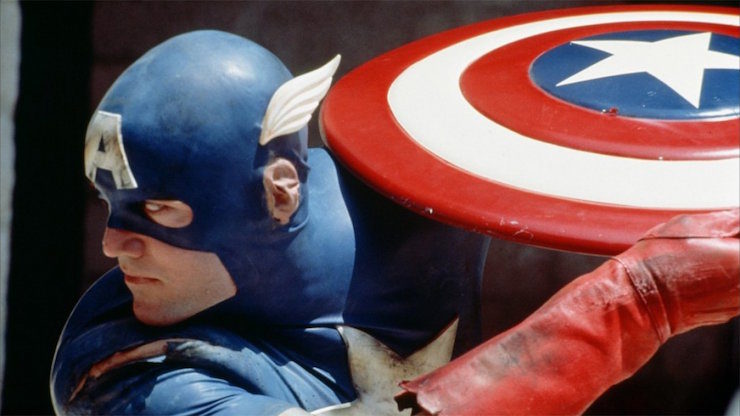
I’d been dreading this week’s rewatch even more than last week’s, but this wasn’t nearly as wretched as I feared. Captain America is just laughably bad, with fundamentally stupid script issues that make it impossible to take seriously. And Fantastic Four was only made in order to keep an option going, and it shows. The special effects are truly pathetic, and it looks like the FF film that a bunch of high school students wanted to throw together with their camcorder.
What’s particularly appalling about Captain America is how utterly ineffectual the title character is. In fact, he’s practically irrelevant. In World War II, he only goes on one mission, and he pretty much fails at it, getting his ass kicked in nothing flat. Yes, he saves the White House (though, again, why did he wait until after the transatlantic flight to kick the tail?), but that’s the sum total of his accomplishments in this movie. Kimball got himself free from his cell, at which point he called the Marines in, and that was pretty much it for the Skull. Without Cap there, he never would have even armed the bomb. And it’s only because Cap was present that Kolawetz and Bernie are killed and Bernie’s husband is wounded. The hero of World War II only went on one top-secret mission, and then he was on ice for fifty years. If it wasn’t for Sharon, he wouldn’t have found out anything about the Skull, and she’s as effective in storming the Skull’s HQ as Cap himself.
Like Reb Brown before him, Salinger at least visually fits the part (the costume actually looks good on him) and is relatively earnest, but he has no discernible personality. The only reason anybody cares about him is because the president and a reporter happen to have an awesome childhood memory associated with him, but that’s pretty much it. I spent the entire movie wondering why Sharon didn’t just tell Cap to go pound sand, since he’s at least partly responsible for the death of her mother.
As mediocre as Salinger is, though, that’s as nothing to how embarrassingly awful Scott Paulin is as the Skull. Putting on a comedy Italian accent that wasn’t even awful enough to be offensive, he’s also only the Red Skull for the WWII segment, as he has plastic surgery in the interim so now he looks—well, still awful, but no longer with bright red skin. (Bobby Morgan of Geeks of Doom said in his review of the film that he looks like he’s wearing a Henry Silva Hallowe’en mask, and that’s really the perfect description.) He’s also only marginally more effective than the hero, as he sends his daughter off to do the real work.
The rest of the cast is actually talented, though they’re wasted in this dreck. Deliverance co-stars Ronny Cox and Ned Beatty are reunited, and are typically excellent despite the best efforts of the script to make them look horrible. (In a nice touch, Beatty’s son Thomas plays the younger version of Kolawetz.) Francesca Neri is also a great actor, though you’d never know it from her pouty, wooden performance here as Valentina, and Kim Gillingham is quite engaging in the dual role of Bernie and Sharon. The true wastes here, though, are Bill Mumy and Darren McGavin as the younger and older versions of Fleming. It’s a terrible role, and both actors deserved better.
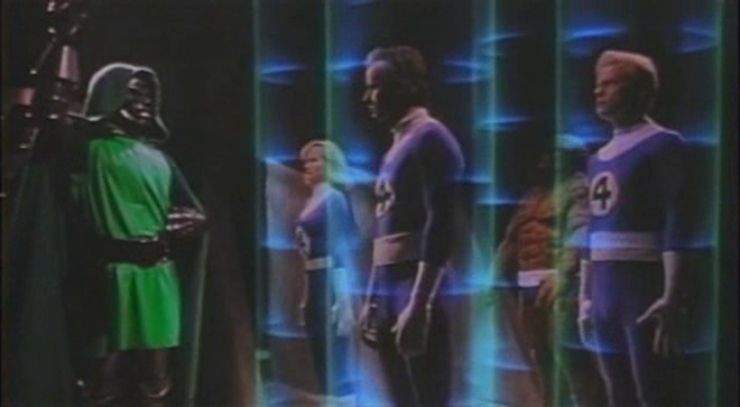
Speaking of embarrassingly awful, we have Fantastic Four, which is one of the most pathetic exercises in filmmaking you’re ever likely to see from a professional movie studio, and that’s even knowing that it was executive produced by Roger Corman, who never met a budget he couldn’t slash.
I will say this much: the one special effect they actually spent more than a buck and a quarter on, the Thing’s rocky body, worked very well. It would’ve worked better if the stunt person in the Thing outfit, Carl Ciarfalio, wasn’t so obviously shorter than the 6’4″ Michael Bailey Smith, who played Grimm.
The rest of the film looks like a 1950s B-movie, only with worse effects. The uniforms look like they were sewn together by a suburban parent who saw a picture of the comic book once, maybe. Richards’s stretching is laughably pathetic, and the gray at his temples looks like it was painted on by anyone other than a professional hair-and-makeup person. Johnny’s flames are beyond silly looking, and von Doom looks like a little kid in a knockoff Dr. Doom Hallowe’en costume.
Both movies are at least mostly true to the characters’ origins. Cap’s in particular follows the same track as the comics, though like his 1970s counterpart, they made him a southern California native instead of being from the lower east side (not Brooklyn!!!!!!) for no compellingly good reason. They also made both the Skull and the scientist who created the super-soldier formula Italian for no compellingly good reason (what, Nazis are too obvious?). At least in Vaselli they give us an Italian character who isn’t a criminal or comic relief (which is what about 95% of all Italian characters in dramatic fiction are, a constant source of irritation to your humble Italian-American rewatcher).
The FF movie also particularly nails the Richards-von Doom rivalry and the sense of family among the foursome, and it deserves credit for that. It’s not clear why the Jeweler isn’t called “the Mole Man,” since he’s very obviously patterned after that character, who was the Fantastic Four’s first opponent in the comics. And while none of the actors playing the heroes in these two movies do much to make their characters stand out or be interesting (Ciarfalio in particular fails to convey the Thing’s inherent tragedy), they are obviously trying their best.
Still, these films’ lack of wide release isn’t exactly a tragedy. They’re a relic of an era when Marvel was desperate to get their properties on the screen and didn’t seem too picky about who they sold the rights to.
Next week, two TV pilots for team shows that never got past the initial production, Generation X and Justice League of America.
Keith R.A. DeCandido is grateful to know that better movies with these characters are coming, all of which will star Chris Evans.










